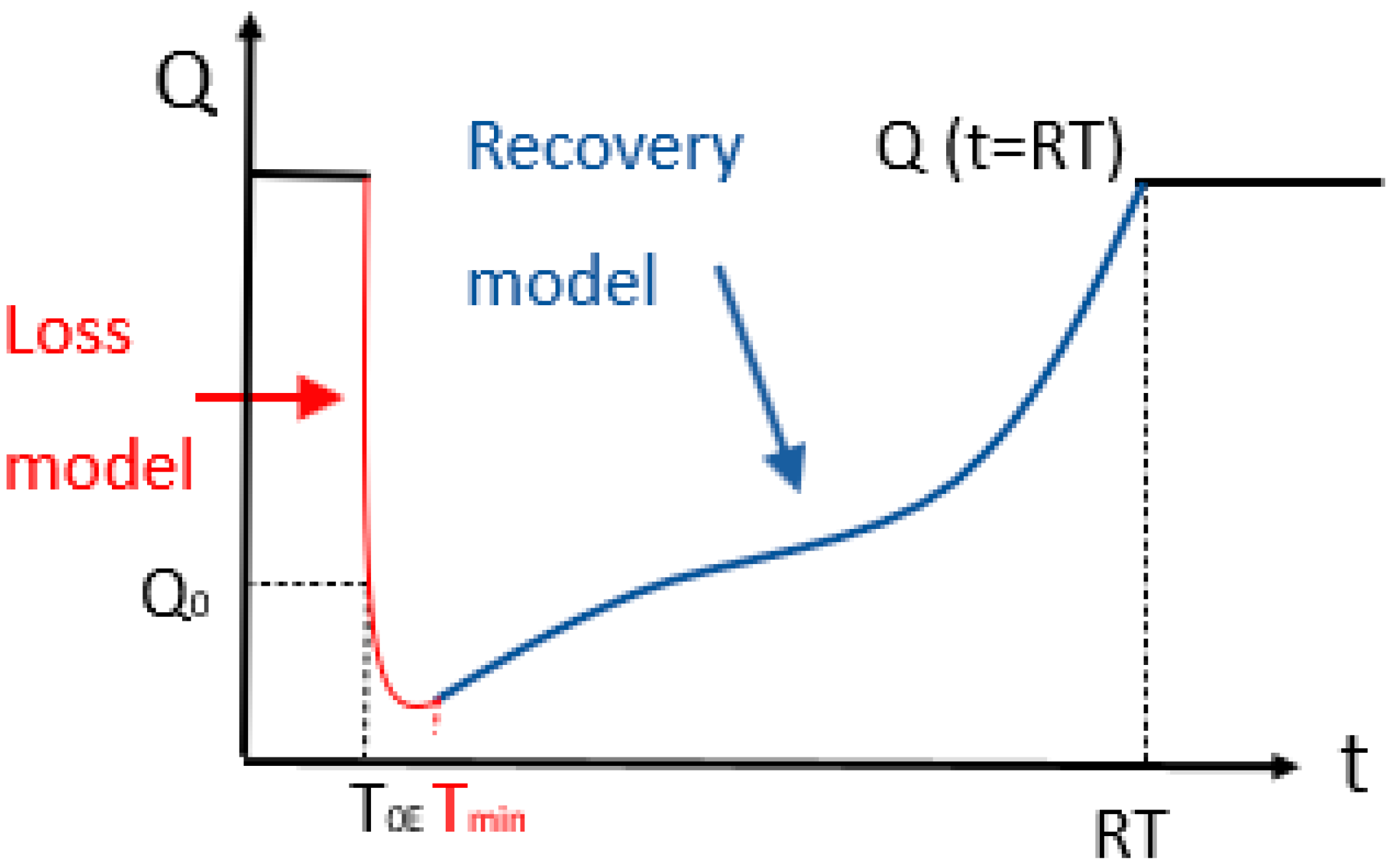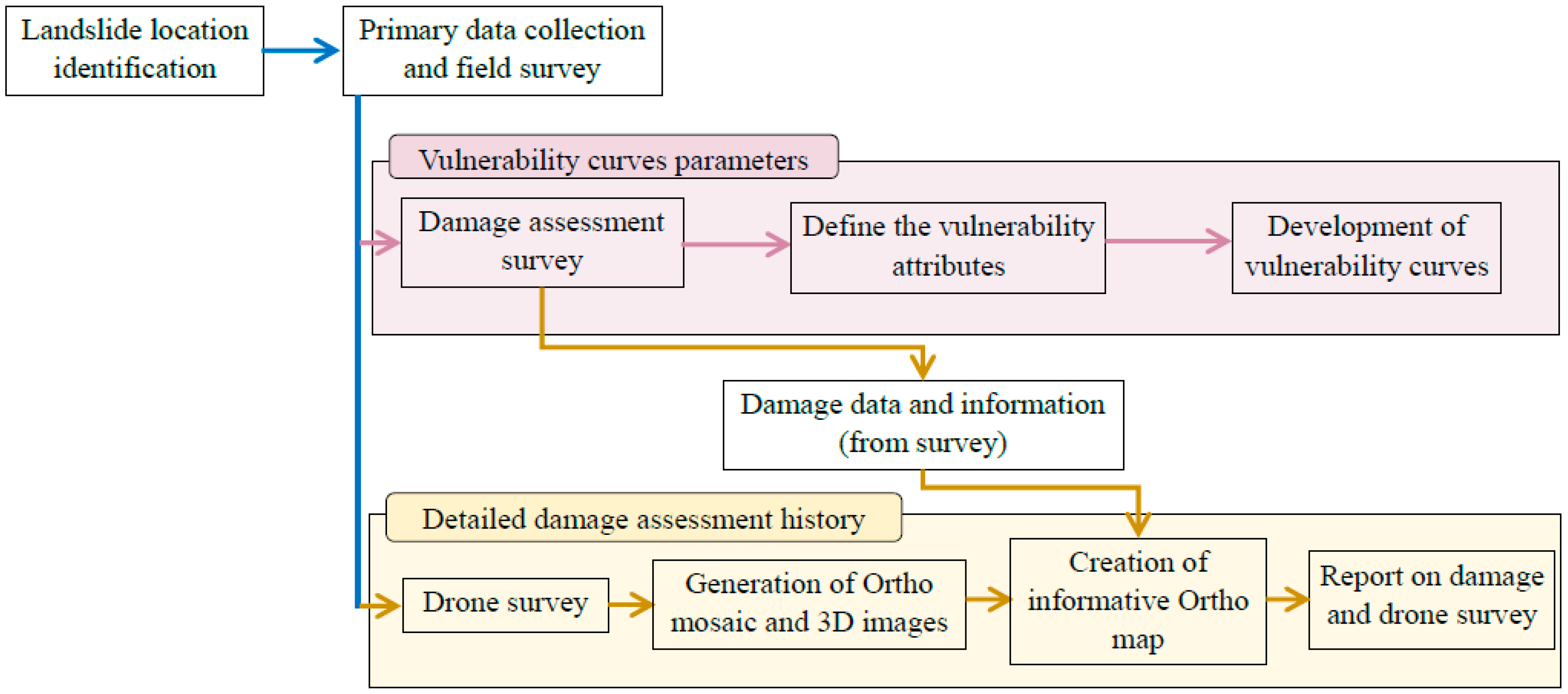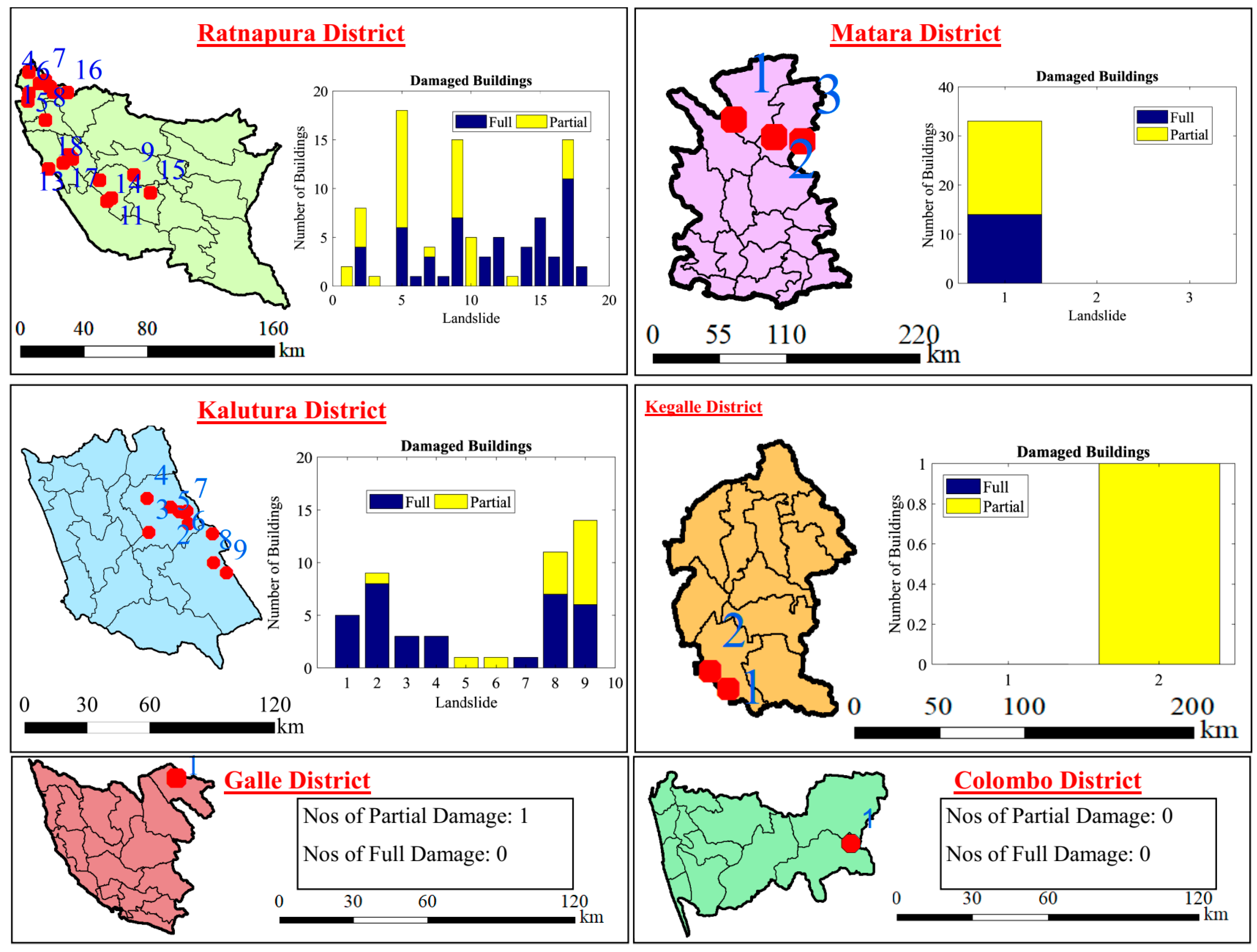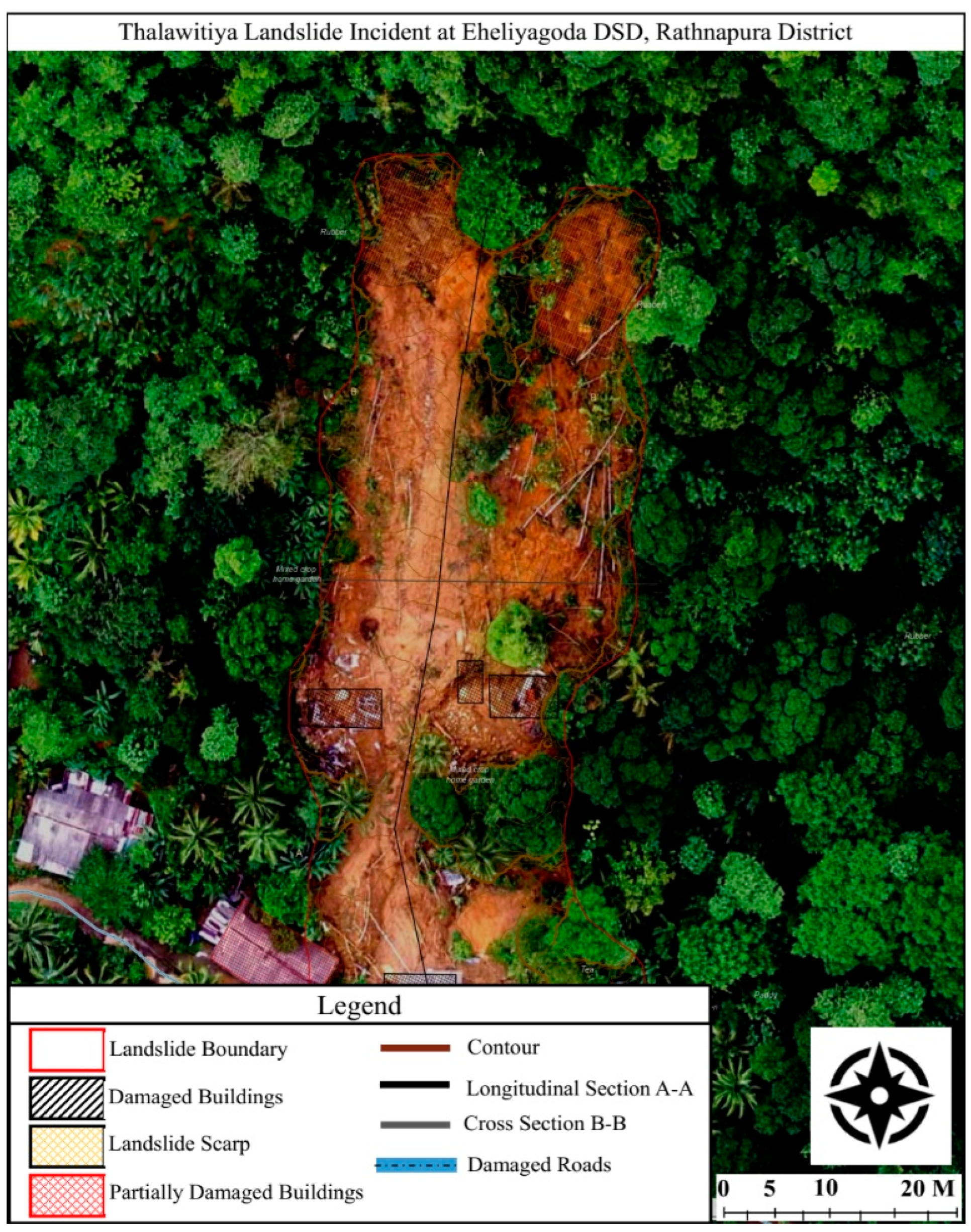A Novel Loss Model to Include the Disruption Phase in the Quantification of Resilience to Natural Hazards
Abstract
1. Introduction
2. Definition of Resilience
- (1)
- Maintaining the integrity of the source (e.g., the natural or artificial resources, such as water or electricity);
- (2)
- Reducing the damage to the channels (e.g., by building robust infrastructures and buildings);
- (3)
- Reducing the impacts (e.g., by building countermeasures and defensive systems, such as seawalls for tsunamis, as studied in [16]);
- (4)
- Performing recovery procedures (e.g., the introduction of buffers to maintain the flow for a limited time when a channel is damaged or destroyed [15]).
3. A Novel Loss Model
4. Landslides in Sri Lanka
Landslide Damage Data
5. Loss Model for Landslide in Sri Lanka
6. Discussion
7. Conclusions
Author Contributions
Funding
Data Availability Statement
Acknowledgments
Conflicts of Interest
References
- Brookshire, D.S.; Chang, S.E.; Cochrane, H.; Olson, R.A.; Rose, A.; Steenson, J. Direct and indirect economic losses from earthquake damage. Earthq. Spectra 1997, 14, 683–701. [Google Scholar] [CrossRef]
- Adey, B.; Hajdin, R.; Brudwile, E. Effect of common cause failures on indirect costs. J. Bridge Eng. 2004, 9, 200–208. [Google Scholar] [CrossRef]
- Zelaschi, C.; De Angelis, G.; Giardi, F.; Forcellini, D.; Monteiro, R.; Papadrakakis, M. Performance based earthquake engineering approach applied to bridges in a road network. In Proceedings of the 5th International Conference on Computational Methods in Structural Dynamics and Earthquake Engineering Methods in Structural Dynamics and Earthquake Engineering (ECCOMAS), Crete Island, Greece, 25–27 May 2015; pp. 900–910. [Google Scholar]
- Cimellaro, G.P. Urban Resilience for Emergency Response and Recovery. Fundamental Concepts and Applications; Geotechnical, Geological and Earthquake Engineering; Springer International Publishing: Berlin/Heidelberg, Germany, 2016; Volume 41, ISBN 978-3-319-30656-8. [Google Scholar]
- Venkittaraman, A.; Banerjee, S. Enhancing resilience of highway bridges through seismic retrofit. Earthq. Eng. Struct. Dyn. 2014, 43, 1173–1191. [Google Scholar]
- Argyroudis, S.A.; Nasiopoulos, G.; Mantadakis, N.; Mitoulis, S.A. Cost-based resilience assessment of bridges subjected to earthquakes. Int. J. Disaster Resil. Built Environ. 2021, 12, 209–222. [Google Scholar] [CrossRef]
- Forcellini, D. Seismic resilience of bridges isolated with traditional and geotechnical seismic isolation (GSI). Bull. Earthq. Eng. 2023, 21, 3521–3535. [Google Scholar] [CrossRef]
- Forcellini, D. 3D Numerical simulations of elastomeric bearings for bridges. Innov. Infrastruct. Solut. 2016, 1, 45. [Google Scholar] [CrossRef]
- Anitori, G.; Casas, J.R.; Ghosn, M. Redundancy and robustness in the design and evaluation of bridges: European and North American perspectives. J. Bridge Eng. 2013, 18, 1241–1251. [Google Scholar] [CrossRef]
- Ghosn, M.; Yang, J.; Beal, D.; Sivakumar, B. Bridge System Safety and Redundancy; Transportation Research Board: Washington, DC, USA, 2014. [Google Scholar]
- Bontempi, F. Elementary concepts of structural robustness of bridges and viaducts. J. Civ. Struct. Health Monit. 2019, 9, 703–717. [Google Scholar] [CrossRef]
- Fiorillo, G.; Ghosn, M. Structural Redundancy, Robustness, and Disproportionate Collapse Analysis of Highway Bridge Superstructures. J. Struct. Eng. 2022, 148, 04022075. [Google Scholar] [CrossRef]
- Ranjbar, P.R.; Naderpour, H. Probabilistic evaluation of seismic resilience for typical vital buildings in terms of vulnerability curves. Structures 2020, 23, 314–323. [Google Scholar] [CrossRef]
- Zhou, Y.; Wang, J.; Yang, H. Resilience of transportation systems: Concepts and comprehensive review. IEEE Trans. Intell. Transp. Syst. 2019, 20, 4262–4276. [Google Scholar] [CrossRef]
- Elms, D. Improving community resilience to natural events. Civ. Eng. Environ. Syst. 2015, 32, 77–89. [Google Scholar] [CrossRef]
- Wachter, R.F.; Forcellini, D.; McManus Warnell, J.; Walsh, K.Q. Relationship between Coastal Hazard Countermeasures and Community Resilience in the Tohoku Region of Japan following the 2011 Tsunami. Nat. Hazards Rev. 2023, 24, 04023017. [Google Scholar] [CrossRef]
- Cimellaro, G.P.; Reinhorn, A.M.; Bruneau, M. Framework for analytical quantification of disaster resilience. Eng. Struct. 2010, 32, 3639–3649. [Google Scholar] [CrossRef]
- Forcellini, D. An expeditious framework for assessing the seismic resilience (SR) of structural configurations. Structures 2023, 56, 105015. [Google Scholar] [CrossRef]
- Norris, F.H.; Stevens, S.P.; Pfefferbaum, B.; Wyche, K.F.; Pfefferbaum, R.L. Community resilience as a metaphor, theory, set of capacities, and strategy for disaster readiness. Am. J. Community Psychol. 2008, 41, 127–150. [Google Scholar] [CrossRef] [PubMed]
- Miles, S.B. Participatory disaster recovery simulation modeling for community resilience planning. Int. J. Disaster Risk Sci. 2018, 9, 519–529. [Google Scholar] [CrossRef]
- Das, L.; Munikoti, S.; Natarajan, B.; Srinivasan, B. Measuring smart grid resilience: Methods, challenges and opportunities. Renew. Sustain. Energy Rev. 2020, 130, 109918. [Google Scholar] [CrossRef]
- Panteli, M.; Trakas, D.N.; Mancarella, P.; Hatziargyriou, N.D. Power Systems Resilience Assessment: Hardening and Smart Operational Enhancement Strategies. Proc. IEEE 2017, 105, 1202–1213. [Google Scholar] [CrossRef]
- Soualah, H.; Jodin, G.; LeGoff Latimier, R.; Ben Ahmed, H. Energy Not Exchanged: A Metric to Quantify Energy Resilience in Smart Grids. Sustainability 2023, 15, 2596. [Google Scholar] [CrossRef]
- Umunnakwe, A.; Huang, H.; Oikonomou, K.; Davi, K.R. Quantitative analysis of power systems resilience: Standardization, categorizations, and challenges. Renew. Sustain. Energy Rev. 2021, 149, 111252. [Google Scholar] [CrossRef]
- Nan, C.; Sansavini, G. Multilayer hybrid modeling framework for the performance assessment of interdependent critical infrastructures. Int. J. Crit. Infrastruct. Prot. 2015, 10, 18–33. [Google Scholar] [CrossRef]
- Sarker, P.; Lester, H.D. Post-Disaster Recovery Associations of Power Systems Dependent Critical Infrastructures. Infrastructures 2019, 4, 30. [Google Scholar] [CrossRef]
- Podesta, C.; Coleman, N.; Esmalian, A.; Yuan, F.; Mostafavi, A. Quantifying community resilience based on fluctuations in visits to points-of-interest derived from digital trace data. J. R. Soc. Interface 2021, 18, 20210158. [Google Scholar] [CrossRef] [PubMed]
- Henry, D.; Ramirez-Marquez, J.E. Generic metrics and quantitative approaches for system resilience as a function of time. Reliab. Eng. Syst. Saf. 2012, 99, 114–122. [Google Scholar] [CrossRef]
- Barker, K.; Ramirez-Marquez, J.E.; Rocco, C.M. Resilience-based network component importance measures. Reliab. Eng. Syst. Saf. 2013, 117, 89–97. [Google Scholar] [CrossRef]
- Karakoca, D.B.; Alomoghathawib, Y.; Barkera, K.; Gonzaleza, A.D.; Mohebbia, S. Community resilience-driven restoration model for interdependent infrastructure networks. Int. J. Disaster Risk Reduct. 2019, 38, 101228. [Google Scholar] [CrossRef]
- Jönsson, H.; Johansson, J.; Johansson, H. Identifying critical components in technical infrastructure networks. J. Risk Reliab. 2008, 222, 235–243. [Google Scholar] [CrossRef]
- Rachunok, B.; Nateghi, R. The sensitivity of electric power infrastructure resilience to the spatial distribution of disaster impacts. Reliab. Eng. Syst. Saf. 2020, 193, 106658. [Google Scholar] [CrossRef]
- Moradi, S.; Vasandani, V.; Student, B.S.; Nejat, A. A review of resilience variables in the context of disasters. J. Emerg. Manag. 2019, 17, 403–432. [Google Scholar] [CrossRef] [PubMed]
- Rouhanizadeh, B.; Kermanshachi, S.; Dhamangaonkar, V.S. Reconstruction of critical and interdependent infrastructure due to catastrophic natural disasters: Lessons learned. In Construction Research Congress 2020; American Society of Civil Engineers: Reston, VA, USA, 2020; pp. 895–904. [Google Scholar]
- Nazarnia, H.; Sarmasti, H.; Wills, W.O. Application of household disruption data to delineate critical infrastructure resilience characteristics in the aftermath of disaster: A case study of Bhaktapur, Nepal. Saf. Sci. 2020, 121, 573–579. [Google Scholar] [CrossRef]
- Chester, M.; El Asmar, M.; Hayes, S.; Desha, C. Post-disaster infrastructure delivery for resilience. Sustainability 2021, 13, 3458. [Google Scholar] [CrossRef]
- Øien, K.; Bosberg, L.; Jovanovic, A. Resilience Assessment of Smart Critical Infrastructures Based on Indicators Safety and Reliability—Safe Societies in a Changing World; Haugen, Ed.; Taylor & Francis Group: London, UK, 2018; ISBN 978-0-8153-8682-7. [Google Scholar]
- Dang, K.; Sassa, K.; Konagai, K.; Karunawardena, A.; Bandara, R.M.S.; Hirota, K.; Tan, Q.; Ha, N.D. Recent rainfall-induced rapid and long-traveling landslide on 17 May 2016 in Aranayaka, Kagelle District, Sri Lanka. Landslides 2019, 16, 155–164. [Google Scholar] [CrossRef]
- NBRO. Hazard Resilient Housing Construction Manual—Resilient Construction Series No. 1, Sri Lanka. 2015. Available online: www.nbro.gov.lk (accessed on 1 January 2024).
- Kalubowila, P.; Lokupitiya, E.; Halwatura, D.; Jayathissa, G. Threshold rainfall ranges for landslide occurrence in Matara district of Sri Lanka and findings on community emergency preparedness. Int. J. Disaster Risk Reduct. 2021, 52, 101944. [Google Scholar] [CrossRef]
- Subasinghe, C.N.; Kawasaki, A. Assessment of physical vulnerability of buildings and socio-economic vulnerability of residents to rainfall induced cut slope failures: A case study in central highlands, Sri Lanka. Int. J. Disaster Risk Reduct. 2021, 65, 102550. [Google Scholar] [CrossRef]
- Mohleji, S.; Pielke, R. Reconciliation of Trends in Global and Regional Economic Losses from Weather Events: 1980–2008. Nat. Hazards Rev. 2014, 15, 04014009. [Google Scholar] [CrossRef]
- Eckstein, D.; Hutfils, M.L.; Winges, M. Global Climate Risk Index 2019, Who Suffers Most from Extreme Weather Events? Weather-Related Loss Events in 2017 and 1998 to 2017. 2018. Available online: https://www.germanwatch.org/en/16046 (accessed on 17 November 2022).
- Santos, L.B.; Jorge, A.A.; Londe, L.R.; Reani, R.T.; Bacelar, R.B.; Sokolov, I.M. Vulnerability analysis in Complex Networks under a Flood Risk Reduction point of view. Nat. Hazards Earth Syst. Sci. 2019, 2019, 1–8. [Google Scholar] [CrossRef]
- Liu, Q.; Tang, A.; Huang, D.; Huang, Z.; Zhang, B.; Xu, X. Total probabilistic measure for the potential risk of regional roads exposed to landslides. Reliab. Eng. Syst. Saf. 2022, 228, 108822. [Google Scholar] [CrossRef]
- Liu, Q.; Zhang, B.; Tang, A. Landslide risk of regional roads: Consider the road mileage of expected losses. Transp. Res. Part D 2023, 120, 103771. [Google Scholar] [CrossRef]
- Sathurshan, M.; Saja, A.; Thamboo, J.; Haraguchi, M.; Navaratnam, S. Resilience of Critical Infrastructure Systems: A Systematic Literature Review of Measurement Frameworks. Infrastructures 2022, 7, 67. [Google Scholar] [CrossRef]








| Level of Redundancy | Description | r |
|---|---|---|
| R01 | High redundancy | r > 50 |
| R02 | Redundancy | 10 < r < 50 |
| R03 | Low redundancy | 2 < r < 10 |
| No | District | GPS N | GPS E | Crown Width (m) | Crown Height (m) | Length of Slide (m) | Fully Damaged Buildings | Partially Damaged Buildings | Percentage of Loss (%) |
|---|---|---|---|---|---|---|---|---|---|
| 1 | Rathnapura | 6°53′46.86″ | 80°12′51.13″ | 44 | 26 | 409 | 0 | 2 | 50.0 |
| 2 | Rathnapura | 6°50′25.38″ | 80°17′3.53″ | 33 | 30 | 103 | 4 | 4 | 75.0 |
| 3 | Rathnapura | 6°51′16.39″ | 80°16′29.24″ | 55 | 18.2 | 196 | 0 | 1 | 50.0 |
| 4 | Rathnapura | 6°51′52.28″ | 80°14′40.10″ | 28 | 23 | 79 | 0 | - | 0.0 |
| 5 | Rathnapura | 6°48′54.68″ | 80°12′43.44″ | 47 | 12 | 168 | 6 | 12 | 66.7 |
| 6 | Rathnapura | 6°50′11.09″ | 80°12′51.64″ | 22 | 12 | 171 | 1 | 0 | 100.0 |
| 7 | Rathnapura | 6°52′23.37″ | 80°15′39.10″ | 42 | 41 | 343 | 3 | 1 | 87.5 |
| 8 | Rathnapura | 6°45′39.78″ | 80°15′39.23″ | 39 | 5.7 | 87 | 1 | 0 | 100.0 |
| 9 | Rathnapura | 6°36′22.81″ | 80°30′42.06″ | 150 | 25 | 580 | 7 | 8 | 73.3 |
| 10 | Rathnapura | 6°35′26.59″ | 80°24′50.83″ | 90 | 25 | 300 | 0 | 5 | 50.0 |
| 11 | Rathnapura | 6°32′25.04″ | 80°26′52.09″ | 110 | 30 | 300 | 3 | 0 | 100.0 |
| 12 | Rathnapura | 6°39′46.64″ | 80°19′38.11″ | 123 | 47 | 482.5 | 5 | 0 | 100.0 |
| 13 | Rathnapura | 6°39′3.69″ | 80°20′13.76″ | 35.5 | 13 | 140.5 | 0 | 1 | 50.0 |
| 14 | Rathnapura | 6°31′53.44″ | 80°26′09.52″ | 96 | 30 | 363 | 4 | 0 | 100.0 |
| 15 | Rathnapura | 6°33′19.68″ | 80°33′33.65″ | 41 | 40 | 105 | 7 | 0 | 100.0 |
| 16 | Rathnapura | 6°50′22.29″ | 80°19′22.46″ | 96 | 30 | 363 | 3 | 0 | 100.0 |
| 17 | Rathnapura | 6°38′23.23″ | 80°18′41.45″ | 22 | 12 | 173 | 11 | 4 | 86.6 |
| 18 | Rathnapura | 6°37′22.96″ | 80°16′11.32″ | 125.4 | 53 | 565 | 2 | 0 | 100.0 |
| 19 | Kegalle | 6°53′1.05″ | 80°16′58.14″ | 42 | 18 | 195 | 0 | 0 | 0.0 |
| 20 | Kegalle | 6°55′16.25″ | 80°14′35.02″ | 12.1 | 5.4 | 52.5 | 0 | 1 | 50.0 |
| 21 | Matara | 6°16′34.53″ | 80°30′10.09″ | 48 | 114 | 2085 | 14 | 19 | 71.2 |
| 22 | Matara | 6°14′35.11″ | 80°34′48.15″ | 14.3 | 8 | 68 | 0 | 0 | 0.0 |
| 23 | Matara | 6°14′7.20″ | 80°37′59.89″ | 27 | 31 | 286 | 0 | 0 | 0.0 |
| 24 | Kaluthara | 6°39′24.84″ | 80°11′37.55″ | 122 | 56 | 695 | 5 | 0 | 100.0 |
| 25 | Kaluthara | 6°38′50.82″ | 80°12′47.49″ | 42 | 54 | 492 | 8 | 1 | 94.4 |
| 26 | Kaluthara | 6°36′19.49″ | 80° 8′56.12″ | 18 | 9 | 394 | 3 | 0 | 100.0 |
| 27 | Kaluthara | 6°40′29.25″ | 80° 8′44.17″ | 50 | 22 | 292 | 3 | 0 | 100.0 |
| 28 | Kalutara | 6°37′20.22″ | 80°13′50.82″ | 9 | 11 | 106 | 0 | 1 | 50.0 |
| 29 | Kalutara | 6°38′45.09″ | 80°13′20.46″ | 12 | 15 | 95 | 0 | 1 | 50.0 |
| 30 | Kalutara | 6°38′56.68″ | 80°13′40.48″ | 41 | 57 | 388 | 1 | 0 | 100.0 |
| 31 | Kalutara | 6°32′34.07″ | 80°17′0.97″ | 55 | 81 | 425 | 7 | 4 | 81.8 |
| 32 | Kalutara | 6°31′6.56″ | 80°18′35.54″ | 300 | 35 | 630 | 6 | 8 | 71.4 |
| 33 | Kalutara | 6°36′7.22″ | 80°16′53.23″ | 15 | 14 | 106 | 0 | 0 | 0.0 |
| 34 | Colombo | 6°51′48.73″ | 80° 9′57.19″ | 43 | 40 | 186.2 | 0 | 0 | 0.0 |
| 35 | Galle | 6°23′28.08″ | 80°23′35.32″ | 44 | 13 | 116 | 0 | 4 | 50.0 |
| Ref. No. | Location | Percentage of Loss (%) | Qmin | r = 3 | r = 6 | r = 10 |
|---|---|---|---|---|---|---|
| 1 | Bogodakanda | 50.0 | 0.50 | 0.333 | 0.133 | 0.037 |
| 2 | Thalawitiya | 75.0 | 0.25 | 0.250 | 0.100 | 0.028 |
| 3 | Thalagahahena | 50.0 | 0.50 | 0.333 | 0.133 | 0.037 |
| 4 | Karandana | 66.7 | 0.33 | 0.277 | 0.111 | 0.031 |
| 5 | Koshena | 100.0 | 0.00 | 0.167 | 0.067 | 0.019 |
| 6 | Bopeththa | 87.5 | 0.12 | 0.207 | 0.083 | 0.023 |
| 7 | Kodithuwakkukanda | 100.0 | 0.00 | 0.167 | 0.067 | 0.019 |
| 8 | Wanniwatta | 73.3 | 0.27 | 0.257 | 0.103 | 0.029 |
| 9 | Udakaravita | 50.0 | 0.50 | 0.333 | 0.133 | 0.037 |
| 10 | Neluwankanda | 100.0 | 0.00 | 0.167 | 0.067 | 0.019 |
| 11 | Alupathgala | 100.0 | 0.00 | 0.167 | 0.067 | 0.019 |
| 12 | Giripagama | 50.0 | 0.50 | 0.333 | 0.133 | 0.037 |
| 13 | Wewelkandura | 100.0 | 0.00 | 0.167 | 0.067 | 0.019 |
| 14 | Bungirikanda | 100.0 | 0.00 | 0.167 | 0.067 | 0.019 |
| 15 | Diddeniya Pahala | 100.0 | 0.00 | 0.167 | 0.067 | 0.019 |
| 16 | Ayagama Town | 86.6 | 0.13 | 0.210 | 0.084 | 0.023 |
| 17 | Muniheenkanda | 100.0 | 0.00 | 0.167 | 0.067 | 0.019 |
| 18 | Welangalle | 50.0 | 0.50 | 0.333 | 0.133 | 0.037 |
| 19 | Morawakkanda | 71.2 | 0.29 | 0.263 | 0.105 | 0.029 |
| 20 | Thibbotukanda | 100.0 | 0.00 | 0.167 | 0.067 | 0.019 |
| 21 | Jayalathgoda | 94.4 | 0.06 | 0.187 | 0.075 | 0.021 |
| 22 | Bogahawatthe | 100.0 | 0.00 | 0.167 | 0.067 | 0.019 |
| 23 | Kobewela | 100.0 | 0.00 | 0.167 | 0.067 | 0.019 |
| 24 | Paragoda West | 50.0 | 0.50 | 0.333 | 0.133 | 0.037 |
| 25 | Niggaha | 50.0 | 0.50 | 0.333 | 0.133 | 0.037 |
| 26 | Demapatapitiya | 100.0 | 0.00 | 0.167 | 0.067 | 0.019 |
| 27 | Athwalthota | 81.8 | 0.18 | 0.227 | 0.091 | 0.025 |
| 28 | Diganna | 71.4 | 0.28 | 0.260 | 0.104 | 0.029 |
| 29 | Kosmulla | 50.0 | 0.50 | 0.333 | 0.133 | 0.037 |
Disclaimer/Publisher’s Note: The statements, opinions and data contained in all publications are solely those of the individual author(s) and contributor(s) and not of MDPI and/or the editor(s). MDPI and/or the editor(s) disclaim responsibility for any injury to people or property resulting from any ideas, methods, instructions or products referred to in the content. |
© 2024 by the authors. Licensee MDPI, Basel, Switzerland. This article is an open access article distributed under the terms and conditions of the Creative Commons Attribution (CC BY) license (https://creativecommons.org/licenses/by/4.0/).
Share and Cite
Forcellini, D.; Thamboo, J.; Sathurshan, M. A Novel Loss Model to Include the Disruption Phase in the Quantification of Resilience to Natural Hazards. Infrastructures 2024, 9, 38. https://doi.org/10.3390/infrastructures9030038
Forcellini D, Thamboo J, Sathurshan M. A Novel Loss Model to Include the Disruption Phase in the Quantification of Resilience to Natural Hazards. Infrastructures. 2024; 9(3):38. https://doi.org/10.3390/infrastructures9030038
Chicago/Turabian StyleForcellini, Davide, Julian Thamboo, and Mathavanayakam Sathurshan. 2024. "A Novel Loss Model to Include the Disruption Phase in the Quantification of Resilience to Natural Hazards" Infrastructures 9, no. 3: 38. https://doi.org/10.3390/infrastructures9030038
APA StyleForcellini, D., Thamboo, J., & Sathurshan, M. (2024). A Novel Loss Model to Include the Disruption Phase in the Quantification of Resilience to Natural Hazards. Infrastructures, 9(3), 38. https://doi.org/10.3390/infrastructures9030038







